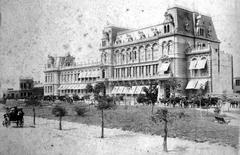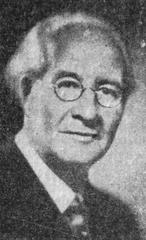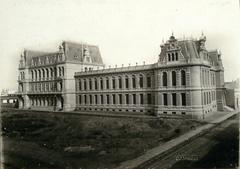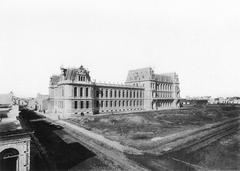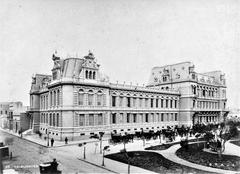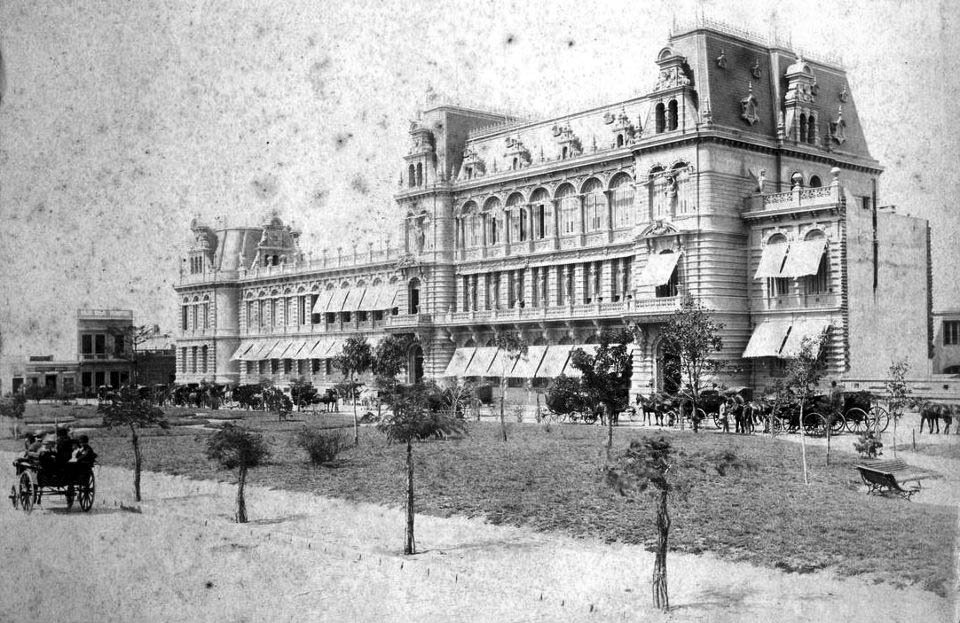
Pizzurno Palace: Visiting Hours, Tickets, and Historical Sites in Buenos Aires
Date: 14/06/2025
Introduction
Nestled in the heart of Buenos Aires’ distinguished Recoleta neighborhood, Pizzurno Palace—officially known as Palacio Sarmiento—stands as a symbol of Argentina’s dedication to education and architectural splendor. Erected in the late 19th century, its striking blend of French Second Empire and Renaissance Revival styles makes it one of the city’s most visually captivating landmarks. More than an architectural gem, Pizzurno Palace is a living testament to Argentina’s educational evolution and civic ambition (Wikipedia).
This comprehensive guide details everything you need to know to plan your visit, from historical background and architectural highlights to practical tips, accessibility, and nearby attractions.
Table of Contents
- Historical Origins and Philanthropy
- Architectural Design and Construction
- Institutional Evolution and Renaming
- Modern Government Use and Restoration
- Visiting Pizzurno Palace: Hours, Tickets & Accessibility
- Nearby Attractions and Photographic Highlights
- Events and Cultural Significance
- Practical Visitor Tips
- Frequently Asked Questions (FAQ)
- References and Further Reading
Historical Origins and Philanthropy
Pizzurno Palace owes its existence to the vision and generosity of Petronila Rodríguez de Rojas. In 1882, her bequest of six hectares of land to the city of Buenos Aires was accompanied by a clear mandate: the creation of educational and charitable institutions, including a school for girls, a church, a home for the elderly, and cultural amenities like a museum and a library (Kiddle). This philanthropic legacy set the stage for the palace’s foundational role in Argentine education.
Architectural Design and Construction
Construction began in 1886 under the guidance of German-Argentine architects Carlos Adolfo Altgelt and Hans Altgelt. Completed in 1888, the palace is a stunning example of eclectic architecture, merging French Second Empire grandeur—characterized by its mansard roofs and ornate façades—with elements of German and French Renaissance Revival styles. The building officially opened as the Petronila Rodríguez de Rojas School in 1893, marking a new era for women’s education and public welfare in Argentina (Kiddle; CABA City).
Institutional Evolution and Renaming
The palace’s function evolved in 1903 when it became the headquarters of the Consejo Nacional de Educación (National Education Council), responsible for overseeing the country’s national secondary schools (Buenos Aires Ciudad). Its association with educational progress was further cemented when the street it faces was named for Pablo Pizzurno, a pioneer in Argentina’s primary education system.
In 1961, on the 150th anniversary of Domingo Faustino Sarmiento’s birth, the building was officially renamed Palacio Sarmiento in honor of the former president and prominent advocate for universal education.
Modern Government Use and Restoration
Following the dissolution of the National Education Council in 1978, the palace became the headquarters of the Ministry of Education. A significant restoration in 1980, led by architect Félix Ruiz Martínez, modernized the facility for contemporary administrative needs while preserving its historical character. The renovation included updates to interior spaces, meeting rooms, and adjacent plazas, ensuring accessibility and ongoing functionality (Buenos Aires Ciudad).
Today, the palace also houses the Biblioteca Nacional de Maestros (National Teachers’ Library), keeping alive its founding mission of fostering knowledge and civic responsibility.
Visiting Pizzurno Palace: Hours, Tickets & Accessibility
- Visiting Hours: Pizzurno Palace functions mainly as a government office and is not open for regular daily public tours. However, it participates in city-wide cultural events—like “La Noche de los Museos”—when guided tours are offered. For the latest public opening times, consult the official Ministry of Education website or Buenos Aires tourism resources.
- Tickets: General exterior viewing is always free. Special event entry is typically free but may require advance registration due to limited capacity.
- Guided Tours: Available only during specific events or by prior arrangement with educational or cultural organizations.
- Accessibility: Surrounding plazas and sidewalks are generally accessible; however, interior mobility accommodations may be limited during events. Always confirm accessibility in advance.
- Location: 935 Pizzurno Street, Recoleta. Easily reached by Subte (Line D, Callao station), numerous bus lines, taxis, and rideshare services.
Nearby Attractions and Photographic Highlights
- Rodríguez Peña Plaza: Directly across from the palace, this green oasis is ideal for relaxation and exterior photography.
- Petronila Rodríguez de Rojas Plaza: Honors the palace’s benefactor and features inviting benches and landscaping.
- Recoleta Cemetery: A world-renowned necropolis just a short walk away.
- Museo Nacional de Bellas Artes: Argentina’s top fine arts museum is in close proximity.
- Avenida Santa Fe: Bustling with shops and cafés, perfect for a cultural stroll.
Photography Tips: The palace’s façade is most photogenic in late afternoon light. Plaza views and adjacent street angles best capture the building’s elaborate stonework and mansard roofs.
Events and Cultural Significance
Pizzurno Palace occasionally opens its doors for public events, educational conferences, and exhibitions—especially during city festivals. These occasions allow visitors to appreciate the lavish interiors and learn about Argentina’s educational heritage. Check the official Buenos Aires cultural calendar for event schedules.
Practical Visitor Tips
- Dress: No dress code for exterior visits; casual attire is fine. For special events, smart casual is recommended.
- Safety: Recoleta is safe, but standard urban precautions apply.
- Amenities: No public restrooms inside; facilities are available in nearby parks, museums, and cafés.
- Language: Spanish is predominant; English is spoken in tourist areas, but using a translation app can be helpful.
- Cash & Connectivity: Carry some Argentine pesos for small purchases. Wi-Fi is widely available in local cafés.
Frequently Asked Questions (FAQ)
Q: Is there a ticket fee to visit Pizzurno Palace?
A: No ticket is required for exterior viewing. Guided tours during special events are free but may need advance registration.
Q: What are the regular visiting hours?
A: The palace is not open to the public on a daily basis. Check for special openings during city events.
Q: Are guided tours in English available?
A: Tours are mainly in Spanish; inquire in advance about English options.
Q: Is the palace accessible for people with disabilities?
A: Exterior areas are accessible, but interior access may be limited. Confirm in advance for special events.
Q: What are the best nearby attractions?
A: Recoleta Cemetery, Museo Nacional de Bellas Artes, Plaza Francia, and Avenida Santa Fe.
References and Further Reading
- Wikipedia
- Kiddle
- Buenos Aires Ciudad
- CABA City
- Intriper
- Journey by Backpack - One Day in Buenos Aires Itinerary
- Official Buenos Aires Tourism Website
Conclusion
Pizzurno Palace is a cornerstone of Buenos Aires’ architectural and educational heritage. While interior access is limited, its grand exterior and surrounding plazas create a memorable destination for travelers seeking to immerse themselves in the city’s history and culture. Combine your visit with neighboring attractions in Recoleta for an enriching experience.
For up-to-date information on events, guided tours, and practical tips, consult official tourism sources and consider using the Audiala app for curated travel guides and local insights. Enjoy your journey through one of Argentina’s most storied landmarks!
